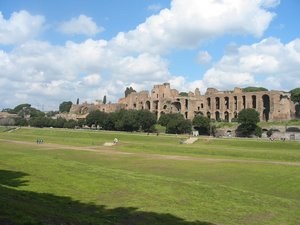Circus Maximus
|
|
The Circus Maximus is an ancient arena and mass entertainment venue located in Rome, Italy.
Situated in the valley between the Aventine and Palatine hills the location was first utilised for public games and entertainment by the Etruscan kings of Rome. Certainly, the first games of the Ludi Romani (Roman Games) were staged on the location by Tarquinius Priscus, the first Etruscan ruler of Rome. Somewhat later, the Circus was the site of public games and festivals influenced by the Greeks in the 2nd century BC. Meeting the demands of the Roman citizenry for mass public entertainment on a lavish scale, Julius Caesar expanded the Circus around 50 BC, after which the track measured approximately 600 metres in length, 225 metres in breadth and could accommodate an estimated 150,000 seated spectators (many more, perhaps an equal number again, could view the games by standing, crowding and lining the adjoining hills). Later, Titus Flavius built the Arch of Titus above the closed end, on the Forum Romanum, while the emperor Domitian connected his new palace on the Palatine to the Circus in order that he could more easily view the races. The emperor Trajan later added another 5000 seats and expanded the emperor's seating in order to increase his public visibility during the games.
The most important event at the Circus was chariot racing. The track could hold 12 chariots, and the two sides of the track were separated by a raised median termed the spina. Statues of various gods were set up on the spina, and Augustus erected an Egyptian obelisk on it as well. At either end of the spina was a turning post, the meta, around which chariots made dangerous turns at speed. One end of the track extended further back than the other, to allow the chariots to line up to begin the race. Here there were starting gates, or carceres, which staggered the chariots so that each travelled the same distance to the first turn.
Sestertius-Caracalla-Circus_Maximus-RIC_0500a.jpg
Very little now remains of the Circus, except for the now grass-covered racing track and the spina. Some of the starting gates remain, but most of the seating has disappeared, the materials no doubt employed for building other structures in medieval Rome. The obelisk was removed in the 16th century by Pope Sixtus V and placed in the Piazza del Popolo. Excavation of the site began in the 19th century, followed by a partial restoration, but there are yet to be any truly comprehensive excavations conducted within its grounds.
The Circus Maximus retained the honour of being the first and largest circus in Rome, but it was not the only example: other Roman circuses included the Circus Flaminius (in which the Ludi Plebeii were held) and the Circus of Maxentius.
de:Circus Maximus fr:Circus maximus hr:Circus Maximus it:Circo Massimo nl:Circus Maximus pl:Circus Maximus pt:Circus Maximus sv:Circus Maximus


